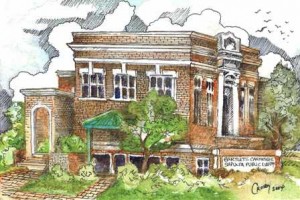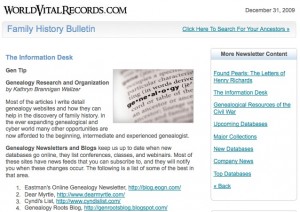January 8th, 2010 Posted in Events, On the Internet, Speaking | Comments Off

Bartlett-Carnegie Sapulpa Public Library Drawing by Russell Crosby
I have been invited to give the program for the February 2 meeting of the recently formed Sapulpa Genealogy Club.
My topic will be “How To Be a Power Hitter: Improve Your Online Searching Skills,” one which is designed to help genealogists work around common problems found in indexes.
View Larger Map
The group meets in Frank Hall — a meeting room on the lower level of the Bartlett-Carnegie Sapulpa Public Library, 27 West Dewey Avenue, in downtown Sapulpa. Meetings begin at 10:00 a.m. and are open to the public.
Tags: Power Hitter, Sapulpa Genealogy Club, Sapulpa Public Library
January 7th, 2010 Posted in On the Internet, Speaking | Comments Off
Ancestry.com reported on its blog on Jan. 4 that they have added more variations of letters & wildcards that may be searched on its website. As long as three letters are included and you provide either the first letter or the last letter, it does not matter what letters you omit. You could search for MacAdoo or McAdoo or Mackado with the same search, by entering M*ado?, whereas previously you were required to enter the first three letters.This sounds exciting to me, and I am looking forward to try it out.
I’ll give this a try on Ancestry Library Edition at TCCL’s Genealogy Center tomorrow,too, to see whether this new feature is available on the library edition as well. At the Tulsa City-County Library, Ancestry Library Edition is available to library card holders at all branches in the system — for free.
I have been asked to present my lecture, “How To Be a Power Hitter: Improve Your Online Searching Skills,” for the new genealogy society in Sapulpa on February 2 at 10:00 a.m. This new development will necessitate some changes to the lecture. But I’ll be glad to do it. I think this is great news.
Read more at this link. And, I’d suggest reading the comments, too.
Tags: Ancestry.com, McAdoo, Power Hitter, Sapulpa, wildcard
January 1st, 2010 Posted in On the Internet | Comments Off

WorldVitalRecords Family History Bulletin
New Year’s Day is always a great time to catch up on emails, stroll around the Internet, and see what’s new in the world of online genealogy. Today I came across yesterday’s posting to the WorldVitalRecords.com’s Family History Bulletin. There were two articles included — one by Kathryn Brannigan Walizer and the other by Dick Eastman. I have a link to Dick Eastman’s blog, I get and read his emails regularly, and I have previously posted links to several of his articles. Yesterday’s article by Eastman was about working around problems with Internet Explorer 8.
Walizer’s article fit quite nicely into how I was feeling and what I was doing on this holiday, and I wanted especially to share it with you. It includes links to sites of interest to genealogists: newsletters and blogs; libraries and archives; articles on research and organization; and social networking for genealogists.
Tags: WorldVitalRecords Walizer Eastman Internet_Explorer
December 7th, 2009 Posted in On the Internet | Comments Off
Dick Eastman, in his Eastman’s Online Genealogy Newsletter blog on Saturday, Dec. 5, highlights an article by genealogist Beau Sharbrough, an expert at online and computer genealogy, on his Unofficial Footnote Blog. On Saturday Beau wrote, updating the unofficial list of online census images and indexes available and in the works. He mentions the four major resources and compares what they have to offer: Ancestry.com; HeritageQuest Online; Footnote; and FamilySearch. We discussed each of these in class, but a brief review might be helpful.
Ancestry.com requires a subscription, but offers thousands and thousands of databases beyond the U.S. Federal Census. Some are indexes only, but many are linked to scanned images of the census pages. You may subscribe directly to Ancestry.com, but you may also use it for no charge, on-site at many libraries, including all branches of the Tulsa City-County Library, and at the Tulsa Genealogical Society.
You may use HeritageQuest Online onsite at the Genealogy Center, a part of the Tulsa City-County Library. Private subscriptions are not available. Of the four resources mentioned, HeritageQuest offers the fewest databases, but I like its census index searching functionality and the quality of its scanned images.
Footnote.com offers millions of records, but not nearly as many databases as those found at Ancestry.com. It is also available by personal subscription, for a much lower cost than that of Ancestry.This subscription is also provided by the Tulsa City-County Library, for use on-site at the Genealogy Center.
FamilySearch is the online resource of the Family History Library and the Church of Jesus Christ of Latter-day Saints. As Beau explains, FamilySearch has partnered with Footnote to enable users access to some of the images, but they have also digitized many of the images themselves, and have a very large body of images and databases. Their indexing project is being accomplished through the use of volunteers. Access to their information is free. The section of their site which offers the U.S. Federal Census images is called Record Search, currently found at this url: http://pilot.familysearch.org/recordsearch/start.html#start.
For specifics, I would recommend reading both posts, both by Dick and by Beau, as well as the comments that follow each.
Tags: Ancestry.com, Beau Sharbrough, census, EOGN, FamilySearch, Footnote, Genealogy Center, HeritageQuest, TCCL, TGS
November 15th, 2009 Posted in On the Internet | Comments Off

Social Security Administration FOIA Request
- Social Security Administration – FOIA
During each of my genealogy courses I describe the value of applications for Social Security, numbered by the Social Security Administration as a Form SS-5. There are places online where anyone can search the Social Security Death Index, including RootsWeb.com, and FamilySearch. These applications were completed by individuals and included such information as name, parents’ names, place of residence, and date and place of birth.
I was recently reminded that these may be ordered online through the Social Security Administration’s website, on the page labelled as “FOIA” (Freedom of Information Act). Here is a link to that page: http://www.ssa.gov/foia/html/foia_guide.htm#FOIARequests . Scroll about halfway down the page to a button, illustrated here in this view of that portion of the page.
Note that two of the options listed on the above page are for a Computer Extract, or Numident print-out. This print-out includes changes made to the individual’s Social Security record over time, which can help in following the name changes of females. The more expensive copy of the original application will provide your ancestor’s signature, and as in the case of any record, will be the original, not a derivative, record as is the computer extract.
For more detailed information about genealogy research using the SSDI (Social Security Death Index), the Railroad Retirement Board Records, and applying for SS-5’s, use this link to the RootsWeb.com’s Guide to Tracing Family Trees: http://www.rootsweb.ancestry.com/~rwguide/lesson10.htm.
Tags: FamilySearch, Railroad, RootsWeb.com, Social Security, SS-5, SSA-711, SSDI


